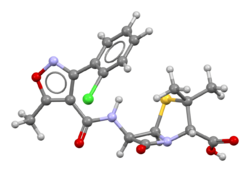Chemistry:Cloxacillin
 | |
 | |
| Clinical data | |
|---|---|
| Trade names | Cloxapen, others |
| AHFS/Drugs.com | Micromedex Detailed Consumer Information |
| Pregnancy category |
|
| Routes of administration | By mouth, IM |
| ATC code | |
| Pharmacokinetic data | |
| Bioavailability | 37 to 90% |
| Protein binding | 95% |
| Elimination half-life | 30 minutes to 1 hour |
| Excretion | kidney and biliary |
| Identifiers | |
| |
| CAS Number | |
| PubChem CID | |
| DrugBank | |
| ChemSpider | |
| UNII | |
| KEGG | |
| ChEBI | |
| ChEMBL | |
| Chemical and physical data | |
| Formula | C19H18ClN3O5S |
| Molar mass | 435.88 g·mol−1 |
| 3D model (JSmol) | |
| |
| |
| (verify) | |
Cloxacillin is an antibiotic useful for the treatment of a number of bacterial infections.[1] This includes impetigo, cellulitis, pneumonia, septic arthritis, and otitis externa.[1] It is not effective for methicillin-resistant Staphylococcus aureus (MRSA).[2] It can be used by mouth and by injection.[1]
Side effects include nausea, diarrhea, and allergic reactions including anaphylaxis.[1] Clostridium difficile diarrhea may also occur.[2] It is not recommended in people who have previously had a penicillin allergy.[1] Use during pregnancy appears to be relatively safe.[1] Cloxacillin is in the penicillin family of medications.[2]
Cloxacillin was patented in 1960 and approved for medical use in 1965.[3] It is on the World Health Organization's List of Essential Medicines.[4] It is not commercially available in the United States.[2]
Mechanism of action
It is semisynthetic and in the same class as penicillin. Cloxacillin is used against staphylococci that produce beta-lactamase, due to its large R chain, which does not allow the beta-lactamases to bind. This drug has a weaker antibacterial activity than benzylpenicillin, and is devoid of serious toxicity except for allergic reactions.[citation needed]
Society and culture
Cloxacillin was discovered and developed by Beecham (now GlaxoSmithKline).[5]
It is sold under a number of trade names, including Cloxapen, Cloxacap, Tegopen and Orbenin.[6]
See also
References
- ↑ 1.0 1.1 1.2 1.3 1.4 1.5 WHO Model Formulary 2008. World Health Organization. 2009. pp. 98, 100, 110–111, 586, 602, 614, 623. ISBN 9789241547659.
- ↑ 2.0 2.1 2.2 2.3 "Cloxacillin (Professional Patient Advice)". https://www.drugs.com/ppa/cloxacillin.html.
- ↑ (in en) Analogue-based Drug Discovery. John Wiley & Sons. 2006. p. 490. ISBN 9783527607495. https://books.google.com/books?id=FjKfqkaKkAAC&pg=PA490.
- ↑ World Health Organization model list of essential medicines: 21st list 2019. Geneva: World Health Organization. 2019. WHO/MVP/EMP/IAU/2019.06. License: CC BY-NC-SA 3.0 IGO.
- ↑ Antimicrobial drugs: chronicle of a twentieth century medical triumph. Oxford University Press US. 2008. pp. 124–. ISBN 978-0-19-953484-5. https://books.google.com/books?id=i4_FZHmzjzwC&pg=PA124. Retrieved 18 November 2010.
- ↑ "Cloxacillin". 2023-05-09. https://vcahospitals.com/know-your-pet/cloxacillin.
External links
- "Cloxacillin". Drug Information Portal. U.S. National Library of Medicine. https://druginfo.nlm.nih.gov/drugportal/name/cloxacillin.
 |

